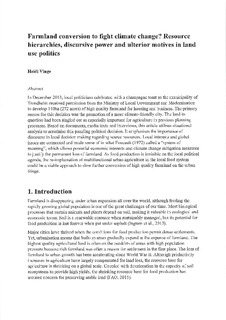| dc.contributor.author | Vinge, Heidi | |
| dc.date.accessioned | 2019-03-07T13:14:10Z | |
| dc.date.available | 2019-03-07T13:14:10Z | |
| dc.date.created | 2018-10-28T19:09:32Z | |
| dc.date.issued | 2018 | |
| dc.identifier.citation | Journal of Rural Studies. 2018, 64 20-27. | nb_NO |
| dc.identifier.issn | 0743-0167 | |
| dc.identifier.uri | http://hdl.handle.net/11250/2589206 | |
| dc.description.abstract | In December 2013, local politicians celebrated with a champagne toast as the municipality of Trondheim received permission from the Ministry of Local Government and Modernisation to develop 110 ha (272 acres) of high quality farmland for housing and business. The primary reason for this decision was the promotion of a more climate-friendly city. The land in question had been singled out as especially important for agriculture in previous planning processes. Based on documents, media texts and interviews, this article utilises situational analysis to scrutinise this puzzling political decision. It emphasises the importance of discourse in local decision making regarding scarce resources. Local interests and global issues are connected and made sense of in what Foucault (1972) called a “system of meaning”, which allows powerful economic interests and climate change mitigation measures to justify the permanent loss of farmland. As food production is invisible on the local political agenda, the re-implantation of multifunctional urban agriculture in the local food system could be a viable approach to slow further conversion of high quality farmland on the urban fringe. | nb_NO |
| dc.language.iso | eng | nb_NO |
| dc.publisher | Elsevier | nb_NO |
| dc.rights | Attribution-NonCommercial-NoDerivatives 4.0 Internasjonal | * |
| dc.rights.uri | http://creativecommons.org/licenses/by-nc-nd/4.0/deed.no | * |
| dc.title | Farmland conversion to fight climate change? Resource hierarchies, discursive power and ulterior motives in land use politics | nb_NO |
| dc.type | Journal article | nb_NO |
| dc.type | Peer reviewed | nb_NO |
| dc.description.version | acceptedVersion | nb_NO |
| dc.source.pagenumber | 20-27 | nb_NO |
| dc.source.volume | 64 | nb_NO |
| dc.source.journal | Journal of Rural Studies | nb_NO |
| dc.identifier.doi | 10.1016/j.jrurstud.2018.10.002 | |
| dc.identifier.cristin | 1624237 | |
| dc.relation.project | Norges forskningsråd: 220691 | nb_NO |
| dc.description.localcode | © 2018. This is the authors’ accepted and refereed manuscript to the article. Locked until 9.10.2020 due to copyright restrictions. This manuscript version is made available under the CC-BY-NC-ND 4.0 license http://creativecommons.org/licenses/by-nc-nd/4.0/ | nb_NO |
| cristin.unitcode | 194,67,25,0 | |
| cristin.unitname | Institutt for sosiologi og statsvitenskap | |
| cristin.ispublished | true | |
| cristin.fulltext | preprint | |
| cristin.fulltext | postprint | |
| cristin.qualitycode | 2 | |

